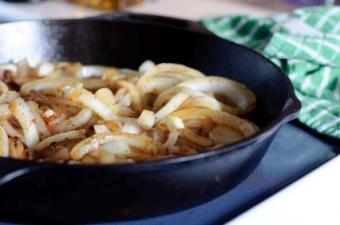
Cookbooks, recipes and restaurants alike are filled with French cooking terms. Adding these words to your vocabulary can help you navigate a gourmet menu or recipe easily.
Where You'll See French Cooking Terms
French cooking terms are nearly everywhere in the gourmet world. Whether you're reading a cookbook by a French chef, or you're ordering a meal in a French restaurant, chances are you'll encounter some unfamiliar terms.
Since most menus and recipes don't stop to explain the technique or the definition of the word, you may be left a bit behind. While this certainly won't stop you from enjoying your meal in a restaurant, it can be a hindrance in the kitchen when you're the one doing the cooking.
Common French Cooking Terms
These common terms are used throughout not only French cooking, but many types of gourmet recipes and meals.
Au jus
Serving a meal au jus means to pour the natural juices from the meat onto the plate just before serving. A gravy can also be made au jus by using the natural juices in the gravy's recipe.
Blanch or Blanchir
To blanch or blanchir means to scald food prior to cooking or freezing. Blancing can remove the skin from tomatoes, or help vegetables maintain their crispness before freezing. To blanch, boil vegetables in salty water until just barely cooked, and quickly submerge them in ice water until cool.
Braise or Braiser
Braising is a technique used to cook tough cuts of meat. The meat is first seared quickly over high heat, and then simmered in liquid in a covered pot until done.
Canapé
Canapés are small pieces of toast, pastry or bread, typically topped with a savory filling. They are most often served with cocktails.
Chemiser
To chemiser a dish means literally, to dress it. This means wrapping an ingredient or dish in parchment or wax paper.
Déglacer
If a recipe has called for you to déglacer or "deglaze" a pan, it means to swirl out the pan with wine or juice to remove the browned bits and remaining flavors from the pan. Do this while the pan is very hot and scrape the pan with a spoon or spatula. Use the resulting liquid in a gravy or sauce.
Ecailler
To ecailler means to open or descale seafood such as mussels or fish.
Ecumer
To ecumer is to skim the foam or skin from the top of a dish.
En croûte
A meal which is en croûte has been wrapped in pastry and then baked.
En papillote
Something cooked en papillote has been wrapped in greased parchment paper.
Filet
To filet (or fillet) is to cut a meat so there are no bones.
Flambé
To flambé is to flame, or add alcohol to a dish which is set on fire. This is a dramatic moment in the making of any meal.
Frémir
To frémir a dish, is to simmer it.
Fricassee
A fricassee is a stewed dish, frequently made of white meat, which has been thickened with a gravy.
Glacé
Glacé means to freeze, ice or glaze a dish such as a dessert.
Julienne
Julienne is the cutting of vegetables up into matchstick sized pieces.
Macérer
To macérer is to cook a meal in a liquid such as alcohol.
Mijoter
Mijoter means to simmer a dish.
Poché
To poché or poach is to cook in simmering water until just done.
Poêler
Poêler is a cooking technique which first involves steaming the dish, followed by frying it in the same pan to help capture the meal's moistness.
Purée
To purée is to reduce to a sauce or paste.
Rectifier
To rectifier is to correct the seasonings of a dish just before serving.
Roux
A roux is a sauce or gravy made from flour.
Sauté
To sauté a dish is to cook it very quickly over direct heat while continuously moving the food to prevent burning.
By familiarizing yourself with these cooking terms, you'll be well on your way to becoming a true gourmand.







